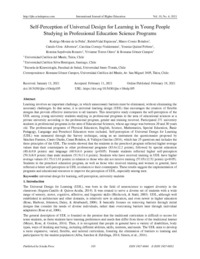Self-perception of universal design for learning in young people studying in professional education science programs
Autor
Monne de la Peña, Rodrigo
Vidal-Espinoza, Rubén
Cossio-Bolaños, Marco Antonio
Urra-Albornoz, Camilo
Quitral-Poblete, Yesenia
Sepúlveda-Romero, Romina
Torres-Olave, Vivianne
Gómez-Campos, Rossana
Fecha
2021Resumen
Learning involves an important challenge, in which unnecessary barriers must be eliminated, without eliminating the
necessary challenges. In that sense, it is universal learning design (UDL) that encourages the creation of flexible
designs that provide effective instruction to all learners. This descriptive study compares the self-perception of the
UDL among young university students studying in professional programs in the area of educational sciences at a
private university according to the professional program, gender and training received. Participated 271 university
students in professional programs in the area of Educational Sciences, whose age range was between 20 and 30 years
old. The professional programs of Physical Education, English, Science, Mathematics, Special Education, Basic
Pedagogy, Language and Preschool Education were included. Self-perception of Universal Design for Learning
(UDL) was measured through the Survey technique, using as an instrument the questionnaire proposed by
Sánchez-Fuentes, Castro Durán, Casas Bolaños, & Vallejos Garcías (2016), which has 25 questions and includes the
three principles of the UDL. The results showed that the students in the preschool program reflected higher average
values than their counterparts in other professional programs (83.6±12.2 points), followed by special education
(60.4±9.8 points) and language (60.8±6.6 points) (p<0.05). Female students reflected higher self-perception
(59.3±8.9 points) than male students (51.8±11.4 points). Students who have received training in UDL have higher
average values (61.75±11.63 points) in relation to those who did not receive training (57.65±12.52 points) (p<0.05).
Students in the preschool education program, as well as those who received training and women in general, have
reflected a better self-perception in UDL in relation to their counterparts. These results suggest the implementation of
programs and educational resources to improve the perception of UDL, especially among men.
Fuente
International Journal of Higher Education, 10(4), 105-112Link de Acceso
Click aquí para ver el documentoIdentificador DOI
doi.org/10.5430/ijhe.v10n4%25pColecciones
La publicación tiene asociados los siguientes ficheros de licencia:



